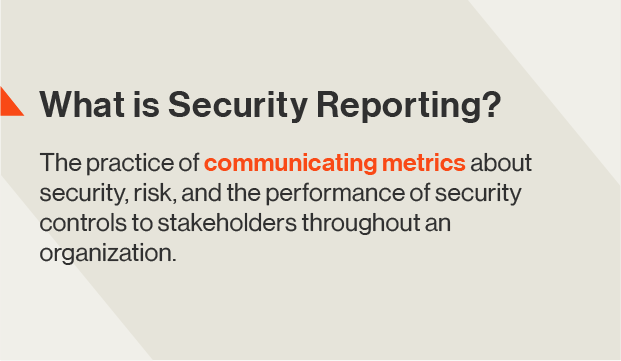Cyber Security Report
Related Content
What is security reporting?
Security reporting is the practice of communicating metrics about security, risk, and the performance of security controls to stakeholders throughout an organization. Executives, boards, security and risk leaders, and security practitioners all require robust reporting to better understand the security landscape and make data-driven decisions about managing risk and enhancing security performance.

Driving data-driven risk decisions with security reporting
Security and risk management professionals today are under great scrutiny. Their companies have spent heavily on cybersecurity programs over the years, and their executives and board members want to understand the return on the substantial investment they’ve made. These stakeholders are also keenly aware of their responsibility for oversight, and they want security reporting that can drive data-driven decisions and conversations about security and risk.
Yet, for security and risk managers, compiling the right metrics for a cyber security report has traditionally been time-consuming and challenging. Many reporting solutions include metrics that are too detailed or too vague to be helpful. Other solutions fail to provide the context that would make the data meaningful to executives and board members who are not steeped in the technical details of cybersecurity.
Bitsight can help. Bitsight’s daily Security Ratings provide a dynamic, data-driven measurement of the security performance of companies and the cybersecurity posture of their vendors. Leveraging this data, security leaders and risk managers can produce cybersecurity reports that effectively measure, manage, and clearly communicate their security programs to senior leadership, board members, and external stakeholders.
What to include in security reporting for the board
Boards and C-suite executives want to be focused on cybersecurity, but they often lack specific knowledge of technical details. Consequently, security reporting at the board and executive level must frame risk in business terms and help leadership understand how cybersecurity impacts the company directly.
Context is critical. Board members and executives won’t have any idea how to interpret data about the number of intrusions in a detection system, for example. To make that information meaningful, it must be presented as part of an historical trend, or as a report that compares the company to competitors and peers. The context for a cyber risk report may include information about past performance, how the metrics appear in different business units, how they compare to peers and competitors, and how they align with cybersecurity frameworks.
When providing metrics, it’s important to only include data that meaningfully communicates risk exposure or security performance. When security leaders provide too much data, it’s harder for the most important areas of risk to get the focus they need. The most pertinent types of metrics include audit and compliance metrics, especially information around fulfillment of legal requirements. Operational effectiveness metrics are also essential – these are the quantitative, down-to-earth metrics that reveal the reality of risk and security performance.
Bitsight Security Ratings enable security reporting that delivers the context and essential metrics required for effective oversight and data-driven decision-making about the investments, priorities, and programs required to measure and reduce cyber risk.
Security reporting with Bitsight
Bitsight reporting capabilities make security performance understandable and accessible to senior leadership, driving more productive conversations about cyber risk. Bitsight’s reporting capabilities allow security and risk management professionals to quickly pull the metrics that are critical to decisions about cybersecurity budgets and programs. Security and risk teams can leverage readily available reports on the security performance of their organization and vendor portfolio or create custom reports on the fly. Security reporting with Bitsight is intuitive and does not require technical knowledge.
Bitsight reports provide:
- Effective communication. Bitsight security reporting encourages data-driven conversations about cyber risk in the business ecosystem.
- Centralized reporting. Reports about security performance and vendor risk can be accessed from a single location in the Bitsight platform giving you a cybersecurity KPI dashboard.
- Customer-defined inputs. Security and risk managers can query their data in the Bitsight platform to produce custom reports that address the organization’s risk tolerance and profile.
- Actionable metrics. Bitsight security reporting allows organizations to determine if their programs and vendors are meeting security performance standards, enabling security teams to take action to remediate vulnerabilities.
Categories of reporting in Bitsight
Bitsight offers several categories of reports that enable security and risk managers to successfully communicate essential metrics and context to board members and executives.
Overview and executive reports are designed specifically for senior leadership. These reports provide straightforward facts about the impact of investments directed at cybersecurity and third-party risk programs. Overview and executive reports provide answers to the common questions posed by company stakeholders, and they facilitate the data-driven conversations about risk and security that are essential to oversight of cybersecurity efforts.
Comparison reports provide a detailed look at how every aspect of a security program compares to the efforts of other companies – including industry leaders, competitors, business partners, and vendors. Leaders can gain insight into the security performance of their peers and critical organizations in their network. Third-party risk managers can use comparison reports to decide between vendors during the onboarding process.
History and trend reports provide historical context that make metrics more meaningful. Security leaders can identify the types of threats that have most impacted their programs over time and which risk-based decisions were most effective at mitigating threats. Third-party risk managers can see which vendors have historically been most vulnerable to bad actors. Trend reports can show which vendors, industries, or tiers have changed over time. Trend reports can also highlight past vulnerabilities and areas of risk that should be the subject of ongoing cyber security monitoring.
Why choose Bitsight?
An industry-leading solution
Bitsight is the world’s leading provider of cyber risk intelligence, transforming how security leaders manage and mitigate risk. Leveraging the most comprehensive external data and analytics, Bitsight empowers organizations to make confident, data-backed decisions and equips security and compliance teams from over 3,300 organizations across 70+ countries with the tools to proactively detect exposures and take immediate action to protect their enterprises and supply chains.
Bitsight customers include 38% of Fortune 500 companies, 4 of the top 5 investment banks, and 180+ government agencies and quasi-governmental authorities, including U.S. and global financial regulators.
Extensive visibility
Bitsight operates one of the largest risk datasets in the world. Leveraging over 10 years of experience collecting, attributing, and assessing risk across millions of entities, we combine the power of AI with the curation of technical researchers to unlock an unparalleled view of your organization. Bitsight offers more complete visibility into important risk areas such as botnets, mobile apps, IoT systems, and more. Our cyber data collection and scanning capabilities include:
- 40 million+ monitored entities
- 540 billion+ cyber events in our data lake
- 4 billion+ routable IP addresses
- 500 million+ domains monitored
- 400 billion+ events ingested daily
- 12+ months of historical data
Superior analytics
Bitsight offers a full analytics suite that addresses the challenges of peer comparison, digital risk exposure, and future performance.
Ratings validation
Bitsight is the only rating solution with third-party validation of correlation to breach from AIR Worldwide and IHS Markit.
Quantifiable outcomes
Bitsight drives proven ROI with significant operational efficiency and risk reduction outcomes.
Prioritization of risk vectors
Bitsight incorporates the criticality of risk vectors in to calculation of Security Ratings, highlighting risk in a more diversified way to ensure the most critical assets and vulnerabilities are ranked higher.
FAQs: What is security reporting?
Security reporting is the practice of communicating metrics about security, risk, and the performance of security controls to stakeholders throughout an organization. Executives, boards, security and risk leaders, and security practitioners all require robust reporting to better understand the security landscape and make data-driven decisions about managing risk and enhancing security performance.
With superior security reporting, organizations can measure, manage, and clearly communicate the risks in their digital ecosystems, the performance of security controls and programs, and the priorities for cybersecurity investments and resources.

